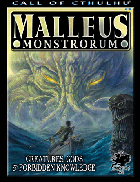
|
About OgreCave and its staff
|

|
by Demian Katz
Call of Cthulhu is all about monsters. Without manuals full of unpronounceable monstrosities, it just wouldn't be the same. Given the importance of dark gods and hideous creatures to the game, it's a little surprising that Malleus Monstrorum was so long in coming. Sure, the core manual has always had a pretty good selection of foes, and this book has a number of precursors in Ye Booke of Monstres I & II and The Creature Companion... but it took 25 years for Chaosium to produce an exhaustive, near-300-page compendium of horrors. In many ways, it was worth the wait, though it has some limitations. Malleus Monstrorum is (if you can follow this) actually an expanded English translation of Pegasus Spiel's expanded German edition of The Creature Companion. The German edition of the book gave it its new name, and more importantly, its striking visual style. Illustration in a role-playing monster book can be a tricky thing. Picking a distinctive look and feel can make a good impression at first, but it often looks painfully dated a few years later (check out the various incarnations of D&D's monster books if you don't know what I'm talking about). Call of Cthulhu offers an even greater challenge since it deals largely with creatures that are generally described as being indescribable. The solution here was to illustrate the book entirely with classic works of art and vintage photos, some real, many cleverly forged. Rather than portraying the horrors of the Mythos directly, it instead presents a collection of artifacts showing its influence on the history of the world. This is totally in keeping with the tone of the game and gives the book a more mature tone; monster books can look a bit silly to the casual observer, but you won't be ashamed to have this one on your shelf. The book also can't be faulted on comprehensiveness or organization. It is split into two main sections: Creatures of the Mythos and Deities of the Mythos, with each subsection featuring indexing for when you need to distinguish between Servitor Races, Elder Gods, Great Old Ones, and whatnot. Smaller sections for non-Mythos fantasy creatures and everyday animals are also included for good measure. The core of the book draws on just about everything you can imagine; obviously, all of the entities from the Lovecraft stories are present, as are creations of more recent authors like Ramsey Campbell and Brian Lumley. Even H.G. Wells' Martians from War of the Worlds get an entry. Many original monsters from earlier Call of Cthulhu scenarios and supplements are also present, and their entries are often expanded or reorganized from their original appearances. The only place where the book fails to deliver practically everything you can think of is on Dreamlands creatures, and this is by choice; the book refers the reader to the separate H.P. Lovecraft's Dreamlands supplement for further research in this area. You have to draw a line somewhere! Entries in the book are quite uniform in format. Each starts with a quote from the story or scenario where the creature first appeared or was best described. It then has several paragraphs (or sometimes a couple of pages) of description of the creature's history, habits and capabilities, followed by the requisite game stats. The quotes are a nice touch, though the dry, descriptive scenario quotes often seem out of place next to the more vivid and dramatic story quotes. The descriptions are undeniably useful, but they often seem a bit too narrow in scope; more contextual information would have been extremely valuable. If you already know what monster you want to use in your campaign, you can find it here and have all the information you need to run encounters with it. However, if you pick a monster at random from the book, you won't necessarily feel immediately inspired to design a scenario around it. Scenario hooks would have been a useful addition, as would more bibliographical information about the literary history of each creature and where to find additional reading material. That level of detail would probably have added quite a few pages to an already thick book, so its absence is understandable, but I would have taken some annotated bibliographies on key creatures over the largely unengaging "Journal of Sir Hansen Poplan" extracts that serve as the book's only attempt at highlighting broader Mythos themes through flavor text. In any case, this volume won't replace something like The Encyclopedia Cthulhiana for general Lovecraftian research, and Lovecraft fans interested in the book for non-gaming purposes will probably be disappointed. The book rounds out its content with an index and a few appendices of material beyond the monster entries themselves - a pronunciation guide, advice on portraying monsters effectively in game sessions, tips on creating new monsters, etc. While I give fanboy credit to the "creating original monsters" appendix for referencing Doctor Who's Fendahl as a possible addition to the game, most of this material is pretty thin and adds little to the book. As a further nitpick, the "Monster Master" sheet provided for tracking monsters looks like a bad blow-up of a poorly compressed JPEG image file. Still, if you came for the monsters, a few slightly unimpressive appendices are unlikely to put you off.
Conclusions
Links:
|
||||
 Malleus Monstrorum:
Malleus Monstrorum: